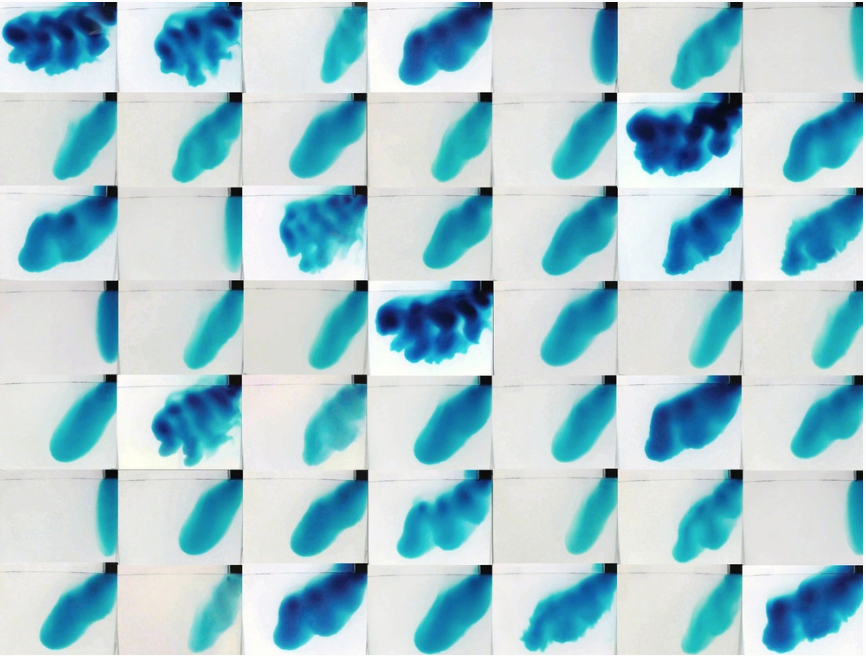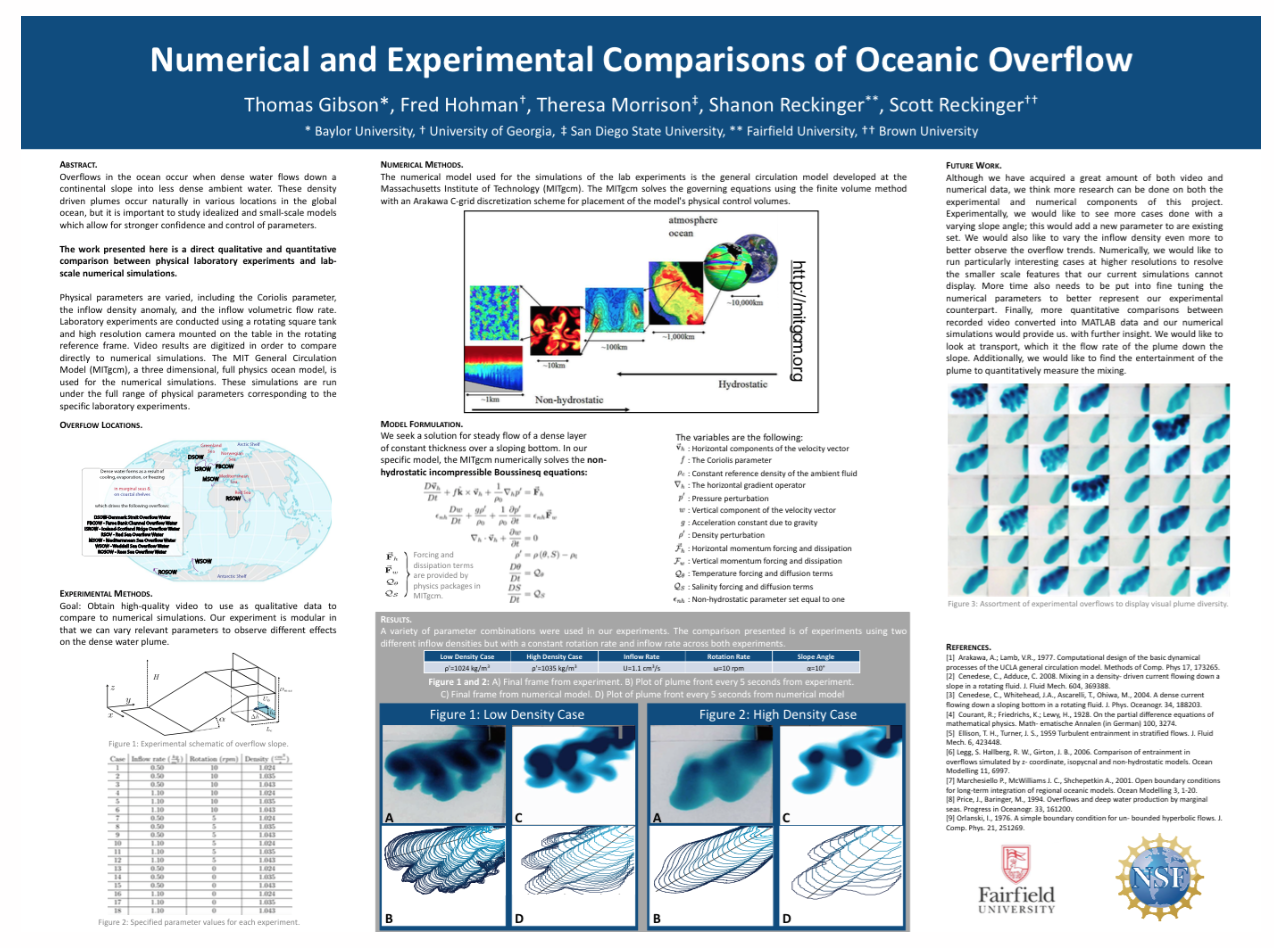story by Helen Hill

Oceanic overflows occur when dense water flows down a continental slope into less dense ambient water. The resulting density driven plumes occur naturally in various regions of the global ocean and affect the large-scale circulation.
General circulation models currently rely on parameterization to represent dense overflows due to resolution restrictions. Such parameterizations rely on a detailed understanding of the mixing properties, which is enhanced by studying idealized, small-scale models of overflows.
Funded by the National Science Foundation, Research Experiences for Undergraduates (REU) are summer research programs for students in science, engineering, and mathematics. In summer 2014 undergraduates Thomas Gibson (Baylor University), Fred Hohman (University of Georgia), and Theresa Morrison (San Diego State University), used MITgcm while participating in Fairfield University’s REU in Mathematics & Computational Science. Supervised by Dr. Shanon Reckinger of the Mechanical Engineering Department at Fairfield University, the team’s project directly compared numerical solutions using MITgcm simulations performed at the lab-scale to model oceanic dense water overflows.
“Our group designed and built an experiment to mimic oceanic overflow while also configuring the MIT General Circulation Model on a linux computer cluster to parallel compute numerical simulations. We then directly compared our experimental data with our numerical simulations using MATLAB for pre- and post-processing visualization,” says Hohman who studies applied math and physics.
Oceanic Overflow Simulation using MITgcm – courtesy Shanon Reckinger
Oceanic Overflows in Rotating Tank – courtesy Shanon Reckinger.
The team presented their research at the REU Mini-Conference at Yale University, the University of Rhode Island Bay Campus, and Fairfield University. Their work was also presented at Los Alamos National Laboratory, Brown University, the American Physical Society (APS) Division of Fluid Dynamics Meeting (2014), and was awarded 1st place in 2015 Joint Mathematics Meeting Undergraduate Poster Session in Computational Mathematics.
Nice work guys!
To find out more about this work contact Fred or Dr. Shanon Reckinger.
This Month’s Featured Publication
Other New Publications this Month
Abhisek Chakraborty, Raj Kumar, Sujit Basu and Rashmi Sharma (2015) Improving Ocean State by Assimilating SARAL/AltiKa Derived Sea Level and Other Satellite-Derived Data in MITGCM, Marine Geodesy (accepted), doi: 10.1080/01490419.2014.1002142
Tom Cowton, Donald Slater, Andrew Sole, Dan Goldberg and Peter Nienow (2015) Modeling the impact of glacial runoff on fjord circulation and submarine melt rate using a new subgrid-scale parameterization for glacial plumes, JGR Oceans (accepted), doi:10.1002/2014JC010324
Pedro Duarte, Philipp Assmy, Haakon Hop, Gunnar Spreen, Sebastian Gerland and Stephen R. Hudson (2015) The importance of vertical resolution in sea ice algae production models, Journal of Marine Science (accepted), doi:10.1016/j.jmarsys.2014.12.004
Yinghui He, Shuqun Cai, Dongxiao Wang and Jianling He (2015) A model study of Luzon cold eddies in the northern South China Sea, Deep Sea Research Part I: Oceanographic Research Papers (accepted), doi: 10.1016/j.dsr.2014.12.007
Thomas Höllt, M. Umer Altaf, Kyle T. Mandli, Markus Hadwiger, Clint N. Dawson and Ibrahim Hoteit (2015) Visualizing uncertainties in a storm surge ensemble data assimilation and forecasting system, Natural Hazards, doi: 10.1007/s11069-015-1596-y
Chris W. Hughes, Rory J. Bingham, Vassil Roussenov, Joanne Williams andPhilip L. Woodworth (2015) The effect of Mediterranean exchange flow on European time mean sea level, Geophysical Research Letters (early view), doi: 10.1002/2014GL062654
Polona Itkin, Martin Losch and Rüdiger Gerdes (2015) Landfast ice affects the stability of the Arctic halocline: Evidence from a numerical model, Journal of Geophysical Research Oceans (accepted), dpi: 10.1002/2014JC010353
Muller-Karger, F.E., Smith, J.P., Werner, S., Chen, R., Roffer, M., Liu, Y., Muhling, B., Lindo-Atichati, D., Lamkin, J., Cerdeira-Estrada, S., and Enfield, D.B. (2015), Natural Variability of Surface Oceanographic Conditions in the Offshore Gulf of Mexico, Progress in Oceanography, doi: 10.1016/ j.pocean.2014.12.007
Mark R. Petersen, Douglas W. Jacobsen, Todd D. Ringler, Matthew W. Hecht, Mathew E. Maltrud (2015) Evaluation of the arbitrary Lagrangian–Eulerian vertical coordinate method in the MPAS-Ocean model, accepted in Ocean Modeling, doi:10.1016/j.ocemod.2014.12.004
Hajoon Song, John Marshall, Peter Gaube and Dennis J. McGillicuddy Jr. (2015) Anomalous chlorofluorocarbon uptake by mesoscale eddies in the Drake Passage region, accepted in Journal of Geophysical Research Oceans, doi: 10.1002/2014JC010292
Xueming Zhu, Guimei Liu, Jia Wang, Hui Wang, Xianwen Bao, and Wei Hu (2015) A numerical study on the relationships of the variations of volume transport around the China seas, Journal of Marine Systems (accepted), doi:10.1016/j.jmarsys.2014.12.003
Do you have news about research using MITgcm? We are looking for contributions to these pages. If you have an interesting MITgcm project (ocean, atmosphere, sea-ice, physics, biology or otherwise) that you want to tell people about, get in touch. To make a post, contact Helen


